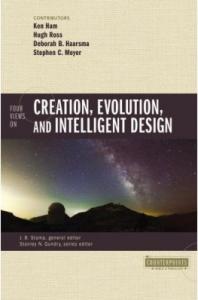 The final essay in the new book Four Views on Creation, Evolution, and Intelligent Design was written by Stephen C. Meyer, Senior Fellow of the Discovery Institute. In this essay he summarizes a history of the design argument and many of the specific arguments for design discussed in much greater detail in his books Signature in the Cell and Darwin’s Doubt.
The final essay in the new book Four Views on Creation, Evolution, and Intelligent Design was written by Stephen C. Meyer, Senior Fellow of the Discovery Institute. In this essay he summarizes a history of the design argument and many of the specific arguments for design discussed in much greater detail in his books Signature in the Cell and Darwin’s Doubt.
First, Meyer’s description of Intelligent Design.
As it applies to biology (the focus of this essay), intelligent design is an evidence-based scientific theory about life’s origin and development that challenges strictly materialistic views of evolution. (p. 179)
The theory of intelligent design holds that there are telltale features of living systems and the universe … that are best explained by an intelligent cause rather than an undirected material process. The theory does not challenge the idea of evolution defined as either change over time or common ancestry, but it does dispute the Darwinian idea that the cause of biological change is wholly blind and undirected. Either life arose as the result of purely undirected material processes or a guiding intelligence played a role. Design theorists affirm the latter option and argue that living organisms look designed because they really were designed. (p. 180)
The specificity of the genetic code, the complexity of the cell, the improbability of random mutation producing beneficial change, and origin of life are all introduced as arguments for the existence of an intelligent designer – something that transcends merely material processes. Intelligent design is not an argument based on biblical interpretation or any specific religious commitment although most proponents do have a religious commitment. This may well be because most people without any religious commitment are by consequence committed to purely materialistic explanations for the origin and complexity of life.
Meyer’s bottom line is that the “specified information” (my quotes not his) in the cell points to intelligent design as the best explanation for the origin of biological information. Much of the reasoning is based on comparison with human language, combination locks, and computer codes. “Since intelligence is the only known cause of specified information, the presence of functional or specified information in even the simplest living system points decisively to the past existence and activity of a designing intelligence.” (p. 201-202) He agrees that the absence of “adequate material cause does provide part of the grounds for inferring design.” (p. 204) However, there is also the positive argument from known cause for information (i.e. human intelligence). This is not only an argument from ignorance.
He also points out that “To be a truth-seeking endeavor, the question origin-of-life researchers must address is not “Which materialistic scenario seems most adequate?” but rather “What actually caused life to arise on Earth?” (p. 206) This is a statement with which most Christians (including me) will agree.
 My own observations. I posted at length on Signature in the Cell (here at Musings on Science) when it first came out, and also once on Darwin’s Doubt (Darwin’s Doubt and Intelligent Design). Although I agree with Meyer that the world shows evidence of design and dispute the idea that “the cause of biological change is wholly blind and undirected,” I don’t find the arguments advanced by Meyer as evidence for design convincing. There are several reasons for this.
My own observations. I posted at length on Signature in the Cell (here at Musings on Science) when it first came out, and also once on Darwin’s Doubt (Darwin’s Doubt and Intelligent Design). Although I agree with Meyer that the world shows evidence of design and dispute the idea that “the cause of biological change is wholly blind and undirected,” I don’t find the arguments advanced by Meyer as evidence for design convincing. There are several reasons for this.
(1) Meyer’s probablistic arguments only work for specific mechanisms and thus only rule out these mechanisms. Protein folding is an example I like to use here. Levinthal’s paradox notes that if proteins fold via a random search of conformational space it would take forever (longer than the age of the universe for many of them). The solution to this paradox is not an intelligent folder (after all we know that intelligence can produce intricate folds, image credit Wikipedia) but a better understanding of the ‘natural’ mechanisms of protein folding. It seems to me that the same is true of the evolutionary process. If one mechanism is insufficient, this should lead to a search for other ‘natural’ mechanisms not to the conclusion that an intelligence is responsible.
(2) The absence of an adequate material cause is the only proof of a designer. More than one possible cause undermines intelligent design as scientific evidence for an intelligent designer. This is why I think that intelligent design is, at best, an argument that must be held loosely with an open hand. The ‘positive’ argument for a designer by comparison with the known action of an ‘intelligent agent’ alone is inconclusive.
(3) As a chemist, I find the analogy between DNA and language or computer code interesting but limited. DNA doesn’t transmit abstract information between minds – rather it encodes material chemical processes. The cell runs on chemical reactions – complex interrelated reactions – but reactions nonetheless. The analogy with a computer code is a little better, but only a little better. Computer code is the result of an intelligent agent but it operates mechanically rather than by the transfer of abstract ideas between minds. The cell is a more “organic” device than any computer or other human machine.
(4) In his analogy with combination locks (described in detail in Signature in the Cell), Meyer dismisses the parallel development of the code and the cell. The DNA code does have elements that are arbitrary, but intricately specified as it operates today – but this does not necessarily lead us down the path to a designer, not even as inference to best explanation.
(5) God’s action in creation is best seen in both ordinary providence and in signs and wonders (extraordinary providence). See the previous post (Ordinary Presence) for more discussion of this point. While the origin of life may involve some kind of direct action of God – perhaps in the accumulation of a number of improbable events – the search for direct evidence is not likely to be conclusive. But our confidence in the providential action of God in creation is independent of evidence for extraordinary providence. Ordinary providence is an awesome demonstration of God’s power.
(6) The best evidence for a designer is not the science of biology (evolutionary or otherwise) but in the meaning and purpose of life. There is no reason to accept that the cause of biological change is blind and undirected – no reason other than a commitment to certain materialist worldviews. I find that the kind of arguments championed by Meyer distract from more important religious arguments for God and for a designed and purposeful creation.
What do you think? Is the search for an intelligent designer a worthwhile one?
What role does intelligent design play in the Christian doctrine of creation?
If you wish to contact me directly, you may do so at rjs4mail[at]att.net
If interested you can subscribe to a full text feed of my posts at Musings on Science and Theology.











